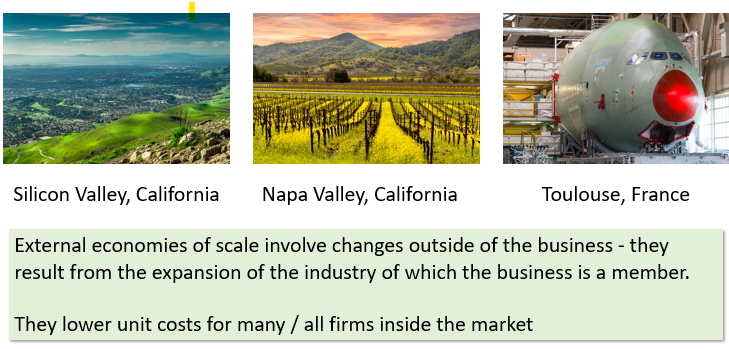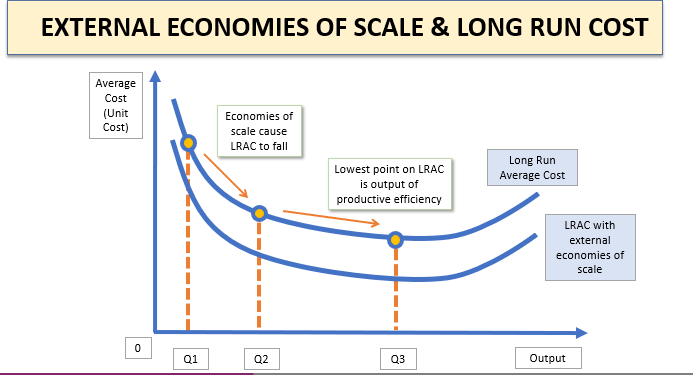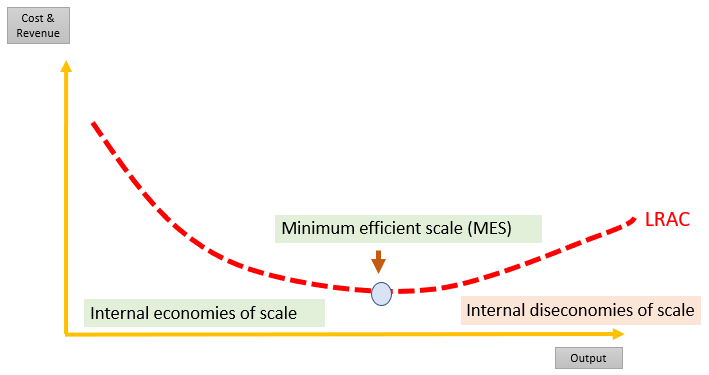Economies of scale
1/17
There's no tags or description
Looks like no tags are added yet.
Name | Mastery | Learn | Test | Matching | Spaced |
|---|
No study sessions yet.
18 Terms
What are economies of scale
•In the long run, all costs are assumed to be variable.
•Internal economies of scale are the unit cost advantages from a business expanding the scale of production in the long run.
•They arise from the benefits of increasing returns to scale. Large-scale production often uses fewer inputs per unit of output.
•Lower average costs are an improvement in productive efficiency and can give a business a competitive cost advantage.
•Economies of scale can lead to lower prices for consumers and higher profits which is good news for shareholders.
Internal and external economies of scale:
Internal Economies of Scale: These arise from within the firm itself as it expands its own operations in the long run. They result from the firm's own actions and decisions.
External Economies of Scale: These arise from factors outside the firm, often related to the industry or the business environment in which the firm operates. They are shared by multiple firms within an industry or geographic region.
Different types of internal economy of scale
Technical economies of scale
Managerial economies of scale
Purchasing economies of scale
Financial economies of scale
Risk-bearing economies of scale
Technical economies of scale
•Specialised Equipment: For example, a manufacturer of computer chips may be able to invest in cutting-edge semiconductor equipment that allows them to produce a larger quantity of chips with high precision, resulting in lower costs per chip.
•Automated Production: Automation reduces the need for manual labour, minimizing errors, and increasing the speed of production.
THE LAW OF INCREASED DIMENSIONS
Law of increased dimensions (also known as the container principle) This is linked to the cubic law – doubling the height and width of a tanker/building leads to a more than proportionate increase in cubic capacity
The application of this law opens the possibility of big scale economies in distribution and freight industries and in travel and leisure sectors with the emergence of super-cruisers. The law of increased dimensions is important in energy sectors, office rental and warehousing. It is significant in long haul airlines and cruise-ships.
MANAGERIAL ECONOMIES OF SCALE
This is a form of division of labour where firms employ specialists to supervise production systems
Better management and increased investment in human resources and the use of specialist equipment, such as networked computers can improve communication, raise productivity, and thereby reduce unit costs.
FINANCIAL ECONOMIES OF SCALE
Financial markets usually rate larger, more established firms to be more credit worthy and have access to loans with favourable rates of borrowing – they may borrow much more overall than a small firm and pay a lower rate of interest (although the bank still benefits because of the large amount borrowed)
Smaller firms often pay higher interest rate on overdrafts and loans. Whereas businesses listed on the stock market can normally raise new financial capital more cheaply through the sale of equities to the capital market.
PURCHASING ECONOMIES OF SCALE
A large firm can purchase factor inputs in bulk at lower prices if it has monopsony power – we can call these purchasing economies.
Large food retailers have monopsony power when purchasing their supplies from farmers and wine growers and in completing supply contracts from food processing businesses.
RISK-BEARING ECONOMIES OF SCALE
Risk-bearing economies of scale can occur when larger businesses are better equipped to manage certain types of risks more efficiently than smaller ones.
This advantage arises from their size, and from product and market diversification to make their business more resilient.
Example: Insurance companies diversify their risk exposure across a wide range of policies and customers
Example: Amazon has since diversified into e-commerce, cloud computing (Amazon Web Services), digital streaming (Amazon Prime Video), and much more!
Economies of scale
Fall in average cost not cost
Pick specific economy of scale never just say “economies of scale”
Economies of scale in beer production
Bulk purchasing - By producing large volumes of beer, companies can negotiate better prices with suppliers for raw materials, such as hops, barley, and yeast.
Production efficiency – Large-scale beer producers can invest in the latest technology to streamline the brewing process, improving productive efficiency and lowering LRAC
Distribution and marketing - By operating on a global scale, these companies can benefit from economies of scale in terms of distribution and marketing.
Research and development - Large beer producers can invest in research and development to create new products, improve production processes, and reduce costs.
Diversification - Companies can spread their risks across different markets, reducing the impact of economic downturns or fluctuations in demand for beer in any one region.
External economies of scale:
External economies of scale occur when the cost advantages of producing a good or service extend beyond an individual firm and benefit multiple firms within a specific industry or geographical area.
External economies of scale provide cost advantages to all firms within an industry or sector, not just to a single firm.
Often, external economies of scale are observed in clusters where businesses in the same industry are in proximity
Reasons for external economies of scale
Infrastructure Economies: If an industry cluster develops in a specific geographic area, firms can benefit from shared infrastructure, such as transportation networks, utilities, and specialized services.
Knowledge and Labour Pool: In certain regions, there might be a concentration of skilled workers and a strong knowledge-sharing environment. Firms in these regions can tap into a well-trained labour force and easily access industry-specific knowledge. Business can benefit from the research activities of local / regional universities.
Supplier Networks: Clusters of related businesses can lead to a strong supplier network. The automotive industry often sees this, as car manufacturers benefit from well-established networks of suppliers providing specialized components.
UK examples of external economies of scale:
•Cambridge - Technology and Biotech: The city of Cambridge, particularly the area known as the "Cambridge Cluster" or "Silicon Fen," is a hub for technology, biotech, and pharmaceutical companies.
•Manchester - Creative and Media Industries: Manchester has a vibrant creative and media industry, with a focus on television, film, music, and digital media.
•Sheffield - Advanced Manufacturing: Sheffield has a tradition in advanced manufacturing in industries such as aerospace, steel, and engineering
•Dundee has developed a notable presence in the video game sector with a cluster of highly successful computer games companies based there.
External economies of scale

What are diseconomies of scale
•Diseconomies of scale are increases in the unit (average) cost of supply in the long run due to decreasing returns to scale.
•Diseconomies of scale mean that a business has moved beyond their optimum size in the long run. Businesses are suffering from productive inefficiency perhaps because of organisational slack.
•Breakdowns in communication may lead to the departure of highly skilled workers from a business – this a loss of human capital for the business
•Businesses then might have to raise their prices to cover increased unit costs.
•Lost cost competitiveness could lead to declining market share and a fall in the share price if the business is on the stock market.
Reasons for diseconomies of scale
•Complexity and Coordination: As an organization grows, it may become more complex, with more (costly) layers of management.
•Bureaucracy: Larger organizations often develop bureaucratic structures to manage the increased complexity. Innovation may slow down as employees / managers become risk-averse.
•Cultural and Organisational Issues: As organisations grow, maintaining a cohesive culture and shared values can become more challenging. This can impact employee morale, motivation, and have a damaging effect on labour productivity.

